Want to take another trip with me down the rabbit hole?

It is said there are no right (or 90-degree) angles in nature.
That is true if you exclude crystals or crystalline structures. Other than that, right angles on our Earth are man-made.
Which makes it really, really intriguing that an amateur space enthusiast claims he’s spotted right angles and rectangles on the surface of Pluto.
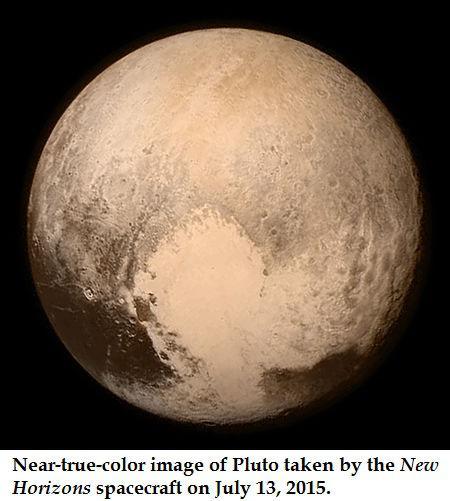
Pluto is a dwarf planet in the Kuiper belt, a ring of bodies beyond Neptune. Primarily made of ice and rock, Pluto is relatively small—about one-sixth the mass of the Moon and one-third its volume.
Discovered in 1930 by Clyde Tombaugh, Pluto originally was considered the 9th planet from the Sun in our Solar System. After 1992, its status as a planet fell into question following the discovery of several objects of similar size in the Kuiper belt. In 2005, the International Astronomical Union for the first time formally defined the term “planet,” resulting in the removal of Pluto from the “planet” category.
Pluto’s distance from Earth — 4.67 billion miles (7.5 billion km) — makes its in-depth study and exploration difficult.
NASA’s New Horizons spacecraft is the first and so far only attempt to explore Pluto directly. Launched in 2006, New Horizons made its closest approach to Pluto 6 days ago on July 14, 2015, after a 3,462-day journey. Scientific observations of Pluto had begun 5 months before the closest approach and will continue for at least another month.
Using images of Pluto taken by New Horizons, below is a video by Joe White of ArtAlienTV, uploaded to YouTube on July 16, 2015. White writes:
“Are these some huge rectangular building structures on the surface of Pluto? Full analysis. They run diagonally to the much smaller pixels so are possibly not due to pixelation. They are not JPEG artifacts as this is a TIFF image. Some of these possible alien city structures are miles across. They must be very large to even show from this distance in this latest Pluto image from NASA’s historic new horizons mission. Some of these diagonal structures may be down to chromatic aberration and the fact that this is a composite of 2 images but the larger structures have shadows so I can’t see how that could explain them all. it looks like the image was deliberately obfuscated by NASA with diagonal blocks so as to hide some of the possible structures.”
In order to enhance the right angles, White undertook the following “manipulations” of NASA’s raw images of Pluto:
- Enhancing light-dark contrasts by making the light lighter and the dark darker.
- Turning enhanced-contrasts images into negatives, both color and black-&-white.
- Zoom close-ups of parts of an image.
Here are screenshots I took from the video. Please ignore a tiny sketch of a hand in some of the screenshots. That’s White’s cursor, which I’d circled in red in the first screenshot below. I’ve also painted red arrows pointing to some of the right angles.
Click images to enlarge
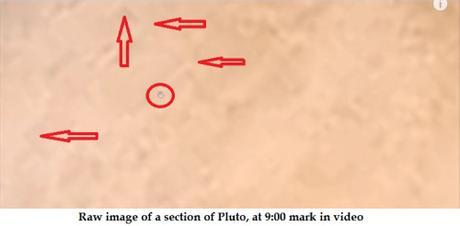
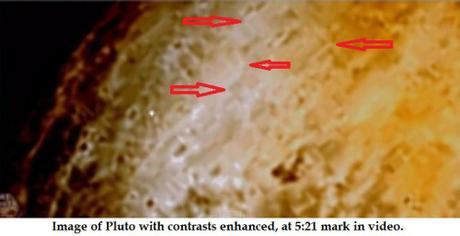
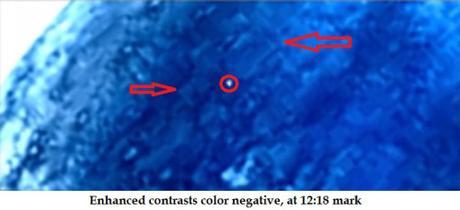
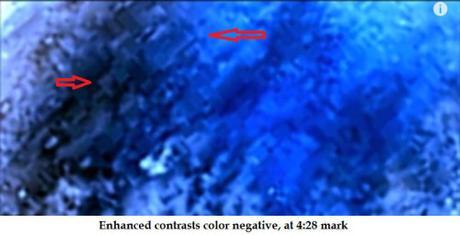
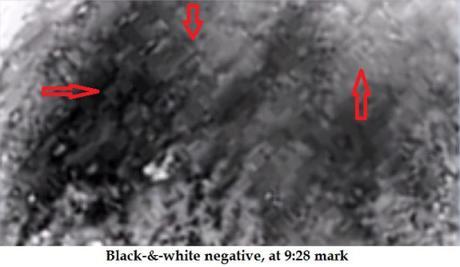
Bear in mind the caveat that these images were taken by New Horizons from a GREAT distance. The great distance could have distorted Pluto’s surface features to make them appear rectilinear, rectangular, and right-angled.
On the other hand, if these indeed are right angles, the implications are mind-boggling. The rectangular structures would be unimaginably HUGE.
~Éowyn

